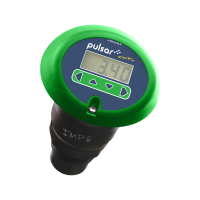PULSAR MEASUREMENT
23
If the device connected to the mA output is out of calibration, and cannot be
calibrated, then the low and high current levels can be trimmed by altering
P838 (Low Trim) and P839 (High Trim). To do this, simply enter the value
that ensures that 4 mA or 20 mA respectively are shown on the remote
device. You can use the left/right menu keys to alter the value until the
correct reading is shown on the remote device, rather than typing in a value.
Using the Relays
All relay related parameters are prefixed with a 2**.
The second digit of the three-figure parameter number denotes the relay
number as follows:
2 1* parameters for Relay 1
22* parameters for Relay 2
The third digit selects specific parameters for the setting up of the relays,
which can be selected individually and results in the following parameter
numbers for each relay.
Relay 1 210 to 218
Relay 2 220 to 228
Each relay can be configured in any of the options shown below, and usually
has two associated set-point values with it (e.g., level) for ON and OFF.
You first need to decide which relays are to be used as alarms. The first
parameter for each relay determines the type of the relay will be (i.e. not in
use, alarm or control.), and what the further relay parameters, applicable to
your selection, represent. Each of these types will now be described.
There are three types that each relay, individually, can be set to, for example,
consider Relay 1, you can select parameter P210 from the following options:
0 = Not in Use relay will remain in the de-energised condition.
1=Alarm: relay will de-energise to set the alarm “ON”.
2=Control relay will energise to set the control “ON”.

